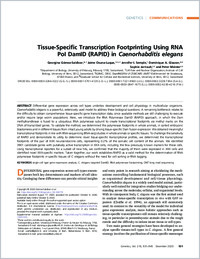Tissue-specific transcription footprinting using RNA PoI DamID (RAPID) in Caenorhabditis elegans
- Gómez-Saldivar, Georgina Department of Biology, University of Fribourg, Fribourg 1700, Switzerland
- Osuna-Luque, Jaime Cell Fate and Nuclear Organization, Institute of Cell Biology, University of Bern, 3012, Switzerland - IGBMC, DBSC Dept/INSERM U1258/CNRS UMR7104/Université de Strasbourg, 67400 France - Graduate School for Cellular and Biomedical Sciences, University of Bern, 3012, Switzerland
- Semple, Jennifer I. Cell Fate and Nuclear Organization, Institute of Cell Biology, University of Bern, 3012, Switzerland
- Glauser, Dominique A. Department of Biology, University of Fribourg, Fribourg 1700, Switzerland
- Jarriault, Sophie IGBMC, DBSC Dept/INSERM U1258/CNRS UMR7104/Université de Strasbourg, 67400 France
- Meister, Peter Cell Fate and Nuclear Organization, Institute of Cell Biology, University of Bern, 3012, Switzerland
-
01.12.2020
Published in:
- Genetics. - 2020, vol. 216, no. 4, p. 931–945
single cell type gene expression analysis
C. elegans targeted DamID
RNA polymerase footprinting
ONT long read sequencing
English
Differential gene expression across cell types underlies development and cell physiology in multicellular organisms. Caenorhabditis elegans is a powerful, extensively used model to address these biological questions. A remaining bottleneck relates to the difficulty to obtain comprehensive tissue-specific gene transcription data, since available methods are still challenging to execute and/or require large worm populations. Here, we introduce the RNA Polymerase DamID (RAPID) approach, in which the Dam methyltransferase is fused to a ubiquitous RNA polymerase subunit to create transcriptional footprints via methyl marks on the DNA of transcribed genes. To validate the method, we determined the polymerase footprints in whole animals, in sorted embryonic blastomeres and in different tissues from intact young adults by driving tissue-specific Dam fusion expression. We obtained meaningful transcriptional footprints in line with RNA-sequencing (RNA-seq) studies in whole animals or specific tissues. To challenge the sensitivity of RAPID and demonstrate its utility to determine novel tissue-specific transcriptional profiles, we determined the transcriptional footprints of the pair of XXX neuroendocrine cells, representing 0.2% of the somatic cell content of the animals. We identified 3901 candidate genes with putatively active transcription in XXX cells, including the few previously known markers for these cells. Using transcriptional reporters for a subset of new hits, we confirmed that the majority of them were expressed in XXX cells and identified novel XXX-specific markers. Taken together, our work establishes RAPID as a valid method for the determination of RNA polymerase footprints in specific tissues of C. elegans without the need for cell sorting or RNA tagging.
- Faculty
- Faculté des sciences et de médecine
- Department
- Département de Biologie
- Language
-
- English
- Classification
- Biological sciences
- License
- License undefined
- Identifiers
-
- RERO DOC 329865
- DOI 10.1534/genetics.120.303774
- Persistent URL
- https://folia.unifr.ch/unifr/documents/308972
Statistics
Document views: 88
File downloads:
- gla_tst.pdf: 198
